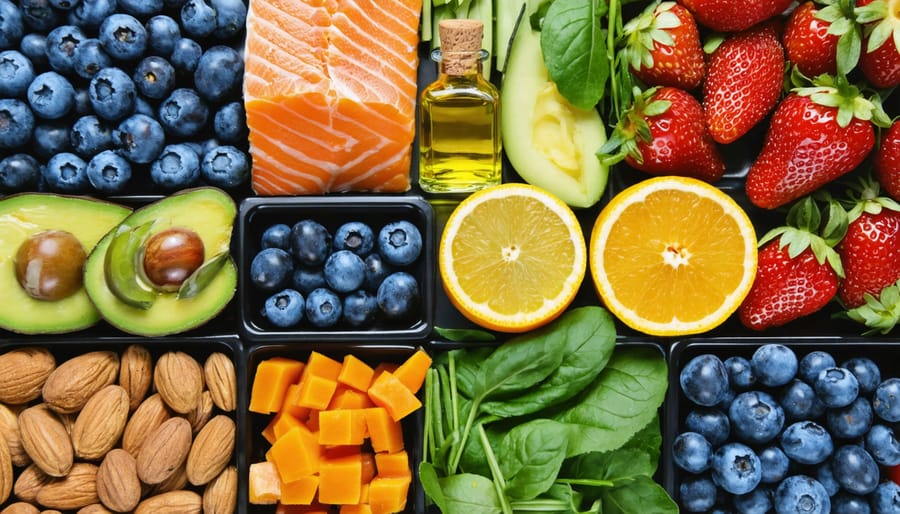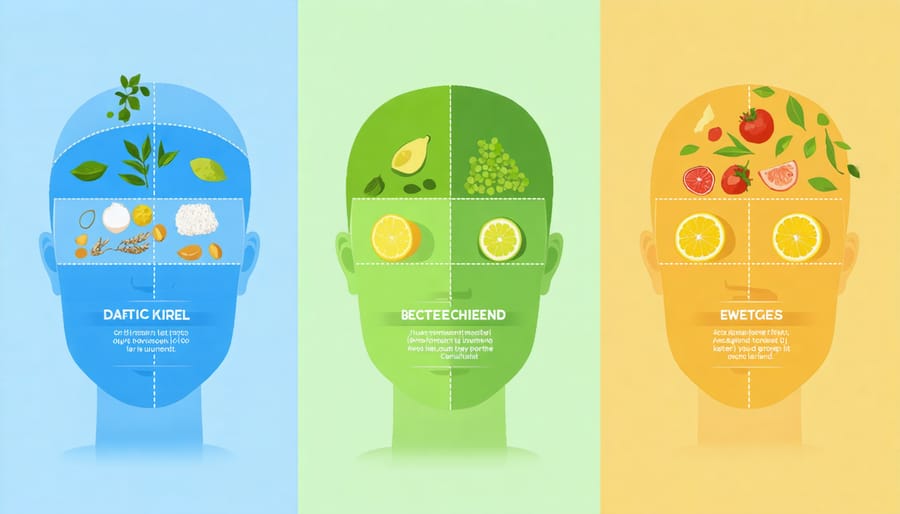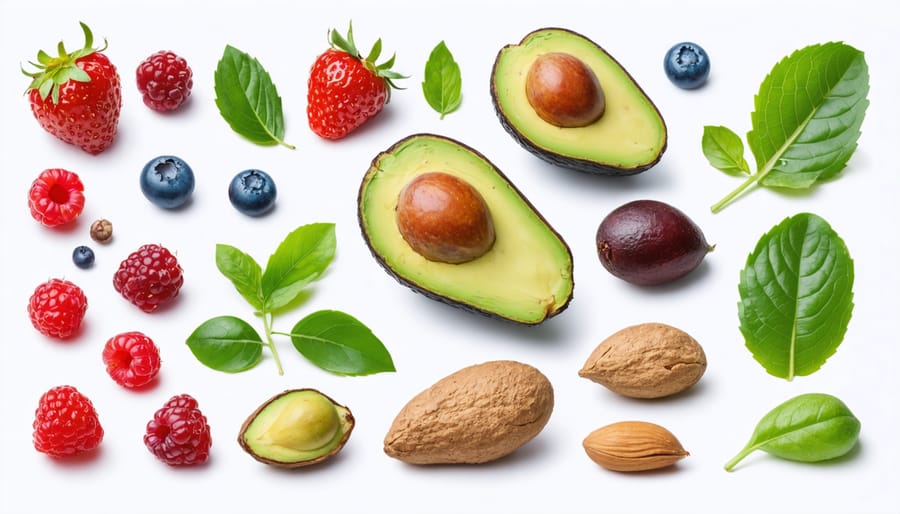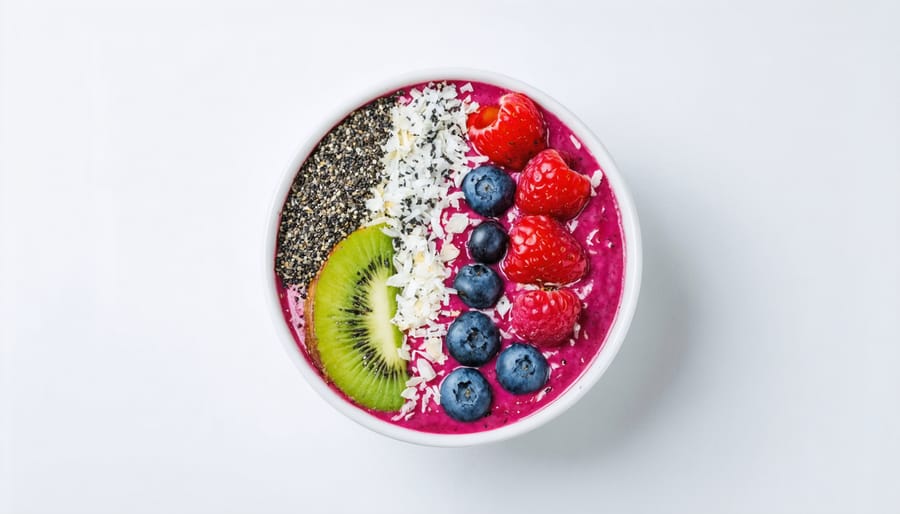
Transform your skin from within by making strategic nutrition choices that feed your complexion. The right foods don’t just nourish your body – they become building blocks for radiant, healthy skin cells. Science shows that specific nutrients directly impact collagen production, skin barrier function, and cellular regeneration.
Load your plate with omega-3 rich foods like salmon, walnuts, and flaxseeds to combat inflammation and maintain skin moisture. Pack in antioxidant powerhouses – berries, leafy greens, and bright orange produce – to fight free radical damage and prevent premature aging. Your skin especially craves vitamin C from citrus fruits and bell peppers to boost collagen production naturally.
Ready to eat your way to better skin? We’ve curated nutrient-packed recipes for glowing skin that make it delicious and easy to nourish your complexion from the inside out. These science-backed nutrition strategies, combined with a consistent skincare routine, create the foundation for the radiant, healthy skin you deserve.
Remember, beautiful skin starts with what’s on your plate, not just what’s in your beauty cabinet. Let’s explore how to feed your skin the nutrients it craves for that natural, healthy glow.
The Science Behind Food and Your Skin
Your Skin’s Nutritional Needs
Just like your body needs the right fuel to function optimally, your skin craves specific nutrients to maintain its radiance and health. Think of your skin as a garden – it flourishes when given the right combination of nutrients! Along with botanical ingredients for skin health, certain vitamins and minerals play crucial roles in maintaining your skin’s vitality.
Vitamin C is your skin’s best friend, supporting collagen production and fighting free radicals. Vitamin E works as a powerful antioxidant, while vitamin A helps with cell turnover and repair. Don’t forget about omega-3 fatty acids – they’re essential for maintaining your skin’s moisture barrier and reducing inflammation.
Zinc deserves special attention as it helps with healing and managing oil production. And let’s not overlook selenium, which helps protect your skin from environmental damage. The beauty of these nutrients is that they work synergistically – meaning they’re even more effective when consumed together through a varied, colorful diet.
Remember, beautiful skin starts from within, and feeding it the right nutrients is like giving your complexion a daily dose of love!

How Your Diet Affects Collagen Production
Ever wondered why some people seem to maintain youthful, bouncy skin well into their forties? The secret might be right on their plate! Your body’s natural collagen production starts declining in your mid-twenties, but here’s the good news: you can support and boost it through your diet.
Let’s start with vitamin C-rich foods – think citrus fruits, strawberries, and bell peppers. These colorful gems are essential for collagen synthesis and help your body create stronger skin structure. Protein-rich foods like eggs, fish, and lean meats provide the amino acids your body needs to build new collagen.
I love adding bone broth to my weekly meal rotation (trust me, it’s not as intimidating as it sounds!). It’s packed with collagen-supporting nutrients and makes a delicious base for soups and stews. For the plant-based folks, foods rich in zinc and copper, like nuts, seeds, and legumes, are fantastic alternatives that support your body’s natural collagen production.
Don’t forget antioxidant-rich foods like berries and leafy greens – they protect the collagen you already have from breaking down too quickly. It’s like having a security system for your skin!

Skin-Loving Superfoods
Antioxidant-Rich Foods
Let’s dive into the vibrant world of skin-nourishing kitchen ingredients that can transform your complexion from within. I’ve discovered that incorporating antioxidant-rich foods into my daily diet has made a remarkable difference in my skin’s appearance, and I’m excited to share these gems with you!
Berries are your skin’s best friends – blueberries, strawberries, and blackberries pack a powerful punch of vitamin C and anthocyanins that help fight those pesky free radicals. I love starting my day with a handful of these colorful treats in my morning smoothie.
Dark leafy greens like spinach and kale are absolute superstars, loaded with vitamins A, C, and E. They’re my go-to for maintaining that natural glow. Sweet potatoes and carrots bring beta-carotene to the table, which helps protect your skin from sun damage (though don’t skip the sunscreen!).
Green tea deserves special mention – it’s rich in polyphenols that combat inflammation and premature aging. I’ve switched my afternoon coffee to green tea, and my skin has never been happier.
Don’t forget about nuts and seeds! Brazil nuts are selenium powerhouses, while sunflower seeds provide essential vitamin E. A small handful makes the perfect skin-loving snack.
Remember, consistency is key – incorporating these foods regularly into your diet will help you achieve that natural, healthy radiance we’re all after.
Hydration Heroes
When it comes to achieving that coveted dewy glow, what you put inside your body is just as important as what you put on it. Think of your skin as a garden – it needs consistent watering from the inside out to stay vibrant and healthy.
Water-rich foods are your skin’s best friends in maintaining moisture and elasticity. Cucumbers, for instance, aren’t just for spa days – they’re 96% water and packed with skin-loving minerals. I personally love adding cucumber slices to my morning water bottle for an extra hydration boost!
Watermelon deserves special mention as a hydration superhero. This summer favorite contains not just water but also lycopene, which helps protect your skin from sun damage. Other juicy fruits like oranges and strawberries deliver a double punch of hydration and vitamin C, essential for collagen production.
Don’t forget about foods rich in healthy fats – they’re crucial for maintaining your skin’s moisture barrier. Avocados, chia seeds, and fatty fish like salmon help lock in hydration from the inside out. I’ve noticed such a difference in my skin’s plumpness since making these a regular part of my diet.
For an extra boost, try incorporating coconut water and green tea into your daily routine. They’re both excellent sources of electrolytes and antioxidants that help your body retain moisture more effectively.
Anti-Inflammatory All-Stars
When it comes to calming angry skin, nature has gifted us with some incredible anti-inflammatory foods that work like internal beauty treatments. I discovered this firsthand when incorporating these powerhouse ingredients into my daily meals made a noticeable difference in my skin’s redness and reactivity.
Let’s start with the omega-3 superstar: wild-caught salmon. This pink beauty doesn’t just taste amazing; it’s packed with fatty acids that help calm inflammation from the inside out. Pair it with vibrant berries – especially blueberries and strawberries – which are loaded with antioxidants that fight free radicals and reduce redness.
Green tea deserves its own spotlight moment. I always keep a cup nearby, not just for its soothing properties but because its polyphenols work wonders for inflammatory skin conditions. Another surprising inflammation fighter? Turmeric. This golden spice has been my secret weapon for years, whether sprinkled in smoothies or added to warming curries.
Don’t forget about leafy greens like spinach and kale, which are rich in vitamins A and K – both essential for skin healing. Walnuts and chia seeds deserve honorable mentions too, offering plant-based omega-3s that help maintain skin’s natural barrier.
The best part? These foods are delicious and versatile. Try starting your day with a berry-packed smoothie bowl topped with chia seeds, or enjoy a salmon and spinach salad for lunch. Your skin will thank you for these delicious additions to your daily menu.
Simple Skin-Boosting Recipes
Glow-Getting Breakfast Bowl
Start your day with a radiant boost using this nutrient-packed breakfast bowl that I absolutely swear by! As someone who’s tried countless morning routines, I can tell you this recipe has become my go-to for that coveted morning glow.
Begin with a base of Greek yogurt (hello, protein and probiotics!) and top it with a colorful array of skin-loving ingredients. Add a handful of mixed berries – strawberries, blueberries, and raspberries are rich in antioxidants that help protect your skin from environmental damage. Sprinkle two tablespoons of chia seeds for those essential omega-3 fatty acids that keep your skin plump and hydrated.
Next, add a drizzle of honey (about a teaspoon) for its antimicrobial properties and natural sweetness. Include a quarter cup of walnuts – they’re packed with vitamin E and healthy fats that support skin barrier function. For an extra boost, throw in some pumpkin seeds, which are rich in zinc for skin healing and renewal.
The secret ingredient? A tablespoon of collagen powder stirred into the yogurt. While the science is still emerging, many of my readers report noticeable improvements in their skin’s elasticity after adding collagen to their morning routine.
This breakfast bowl not only tastes delicious but also provides your skin with essential nutrients to maintain that healthy, natural glow throughout the day. The best part? It takes just five minutes to prepare!

Complexion-Loving Lunch
Lunchtime is your golden opportunity to pack in those skin-loving nutrients that’ll keep you glowing through the afternoon slump. I love creating what I call my “rainbow bowl” – a colorful medley of ingredients that work overtime for your complexion.
Start with a base of dark leafy greens like spinach or kale, which are rich in vitamin A and C – your skin’s best friends for collagen production. Add a portion of wild-caught salmon or sardines for those essential omega-3 fatty acids that help maintain skin moisture and reduce inflammation. Trust me, your future self will thank you!
For extra skin-boosting power, toss in some avocado chunks (hello, vitamin E!), and a handful of orange segments or bell peppers for their vitamin C content. I always include some pumpkin seeds for their zinc content – it’s like nature’s little acne-fighting supplement.
Don’t forget to drizzle your bowl with an antioxidant-rich dressing made from olive oil, lemon juice, and a touch of honey. This combination not only tastes amazing but also helps protect your skin from oxidative stress.
If you’re pressed for time, even a quick salmon wrap with avocado and greens will do the trick. Remember, consistency is key – making these ingredients a regular part of your lunch routine can lead to visible improvements in your skin’s appearance over time.
Radiant Skin Dinner
Let me share my favorite evening recipe that’s become my secret weapon for waking up to glowing skin. This nourishing dinner combines ingredients that work overtime while you sleep, supporting your skin’s natural repair process.
Start with a base of wild-caught salmon, rich in omega-3 fatty acids and protein – essential building blocks for skin repair. Pan-sear it with a touch of olive oil and fresh herbs. On the side, prepare a colorful mix of sweet potatoes (loaded with skin-loving vitamin A) and steamed broccoli (packed with vitamins C and K).
The star of this plate is my signature beauty-boosting quinoa salad. Combine cooked quinoa with pomegranate seeds, walnuts, and dark leafy greens. The antioxidants in pomegranate help fight free radicals while you rest, and walnuts provide essential fatty acids that support skin barrier function.
For extra overnight glow, finish with a small bowl of cherries or kiwi slices. These fruits are natural sources of melatonin, which not only helps you sleep better but also supports skin cell regeneration.
Remember to enjoy this meal at least two hours before bedtime to allow proper digestion. Pair it with a cup of caffeine-free green tea or chamomile for added antioxidant benefits. Trust me, your skin will thank you in the morning with a natural, well-rested radiance!
As we’ve explored throughout this article, the path to radiant, healthy skin isn’t just about what you put on your face – it’s equally about what you put on your plate. The powerful connection between nutrition and skin health is something I’ve personally experienced, and I’m excited for you to begin this transformative journey too.
Remember, the key nutrients we’ve discussed – antioxidants, healthy fats, vitamins A, C, and E, and protein – work together to create your skin’s natural defense system. By incorporating colorful fruits and vegetables, fatty fish, nuts, and seeds into your daily meals, you’re essentially feeding your skin from within.
I’ve seen remarkable changes in my own skin since prioritizing nutrition, and many of our community members have shared similar success stories. Start small – perhaps with a antioxidant-rich breakfast smoothie or adding an extra serving of leafy greens to your lunch. These simple changes can make a significant difference over time.
Think of your nutrition-focused skincare routine as a long-term investment in your skin’s health. While topical products provide immediate benefits, the foundation of truly healthy skin begins with what’s on your fork.
Don’t feel pressured to make all these changes at once. Choose one or two strategies that resonate with you and gradually build from there. Maybe start with increasing your water intake and adding more colorful vegetables to your meals. As these habits become natural, you can explore more of the nutritional recommendations we’ve discussed.
Remember, everyone’s skin is unique, and what works for one person might not work for another. Listen to your body, pay attention to how your skin responds to different foods, and adjust accordingly. The journey to beautiful skin through nutrition is personal and should be enjoyable, not stressful.
Here’s to your journey toward healthier, more radiant skin – one nutrient-rich meal at a time!



